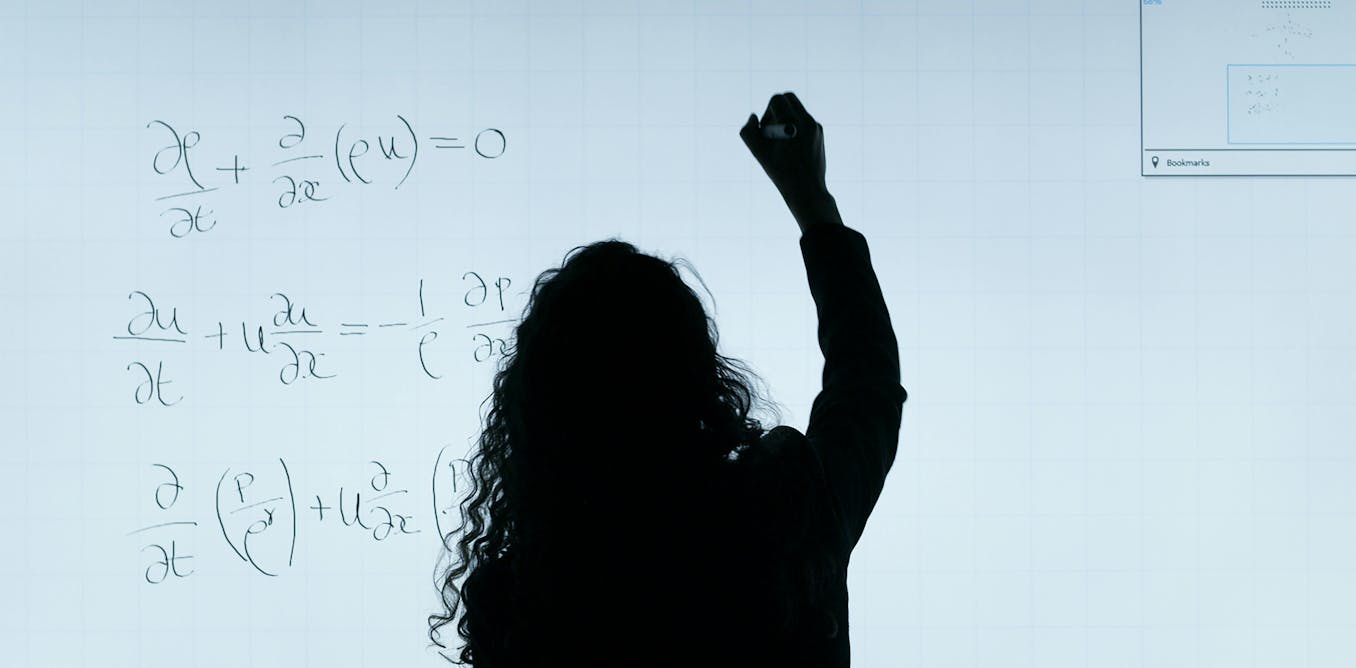It was Cold War–era Southern California. Aerospace and aviation initiatives were cropping up left and right. This was the perfect setting: clear skies almost every day, great for flying and quite unlike conditions in the Soviet Union, enemy number one. And so, in California, new discoveries in physics, optics, and math were born—rigorously researched and then applied, becoming the stuff of rocket science.
A subtle retort to my-kid-could-do-that dismissals of abstract painting, a new exhibition at the Palm Springs Art Museum shows how American abstraction involved rocket science, too. Or some of it, at least. “Particles and Waves: Southern California Abstraction and Science, 1945–1990” surveys work by a couple dozen SoCal science-curious artists (a few of whom were actual rocket scientists, though most were simply influenced).
Frank Malina opens the exhibition, and is a kind of lynchpin, too. Malina, a leading rocket scientist at Caltech’s Jet Propulsion Laboratory by 1946, gave it all up in the mid-’50s to make kinetic art. In ’68, he founded the influential journal Leonardo, an early and enduring publication covering art, science, and technology.
Other artists collaborated or dabbled. How could they resist? They were witnessing major changes in how we perceive and understand the world. I mean, people were dropping atomic bombs and landing on the moon!
With all these new tools, humans could perceive much more than the eye could behold, more than the mind could comprehend. Technology exploded the human sensorium, making it a prosthetic, per the media theorist Marshall McLuhan. Why respond with a mere painting of the ordinary things in front of you?
By the 1950s, Helen Lundeberg began exploring a realm beyond the everyday, foregoing her social realism to create a series of planet-inspired paintings, just as our species began exploring the extraterrestrial realm. She started leaving figuration behind to embrace realms unknown. Her subsequent paintings of sectioned or ringed orbs would go on to lay the groundwork for a movement known as Hard Edge abstraction.
At the same time, computer-aided design, research in optics and physics, color theories, and new plastics were changing visual vocabularies. Two upcoming shows this fall, “Electric Op” at Buffalo AKG and “Electric Dreams” at the Tate, likewise argue that technology and abstraction went hand-in-hand—as formal and scientific innovations always have, from linear perspective to the camera obscura. Before the Enlightenment, art and science were one. Religion, too, for that matter—all three chasing versions of the Mystery.
If that’s a little woo-woo for you, fear not: there’s lots of technical, practical, empirically proven stuff in the Palm Springs show. In fact, the catalog and wall labels tend toward straightforward, just-the-facts text: never “why,” only “how.” The opening section of “Particles and Waves,” titled “Color in Motion,” displays systematic color theories as worked out by the likes of Hilaire Hiler, Sam Erenberg, and Stanton Macdonald-Wright, all color for color’s sake, systematized and ordered.

Many works in the show belong to the California Light and Space movement, which owes a lot to the Space Race, though Abstract Expressionism tends to get all the attention for its role in the Cold War Military Industrial Complex. The “Optics” section employs cutting-edge optics research in the service of transcendent experiences and fun optical tricks. There are Fred Eversley’s parabolic lenses, which he made shortly after leaving his job on NASA’s Apollo Mission. An early Robert Irwin, Untitled (1963–65), looks like a white painting until you get up close and see that it’s vibrating dots of purple and green. It shows you how it works a way that doesn’t spoil the magic, but rather adds to it—like Norman Zammitt’s Plastic Cube (1970–72), in which several versions of an iridescent honeycomb image are suspended in a block of resin to create a dizzying effect.
These weird experiments were made in an environment unencumbered by institutions and critics synonymous with East Coast elitism. Things were experimental enough that when Light and Space icon Larry Bell picked up a copy of a physics book by Leslie Holland—Vacuum Deposition of Thin Films, from 1961—he decided to give its ideas a try, soon after covering sheets of glass in thin sheets of film that reflected and refracted light. These works would go on to become Bell’s signature. Despite this physics research, Minimalists with a capital “M” in New York dismissed Light and Space’s colorful, immersive work as unserious—as if to say “real men do not make their squares in pink.”

Speaking of men, a less-expected inclusion is the feminist icon Miriam Schapiro, known for cofounding Womanhouse with Judy Chicago and for her contributions to the Pattern and Decoration movement. Before all that, she was using early 3D-modeling software, which required collaboration with a physicist, in part because the program was not yet publicly available. Between 1967 and 1970, she made computer-assisted Hard Edge paintings.
“Particles and Waves” is the show that seems to have best-understood the assignment of this year’s sprawling Getty-funded initiative PST: Art & Science Collide, which spans more than 60 exhibitions across Southern California. The works in the show involve actual art and actual science, and the whole is more than the sum of its parts. Today’s generation of science-curious artists would be wise to take note of the way this cohort synthesized research into formal, aesthetic experiences—into something wholly their own.

The post “How The Space Race Impacted American Abstraction” by Emily Watlington was published on 09/20/2024 by www.artnews.com







































Leave a Reply